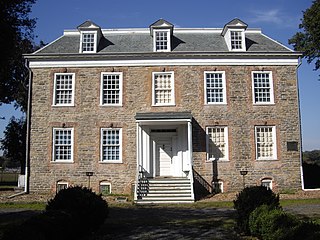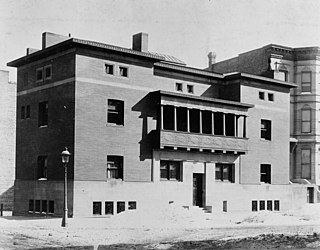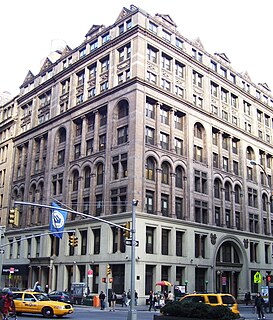
The Van Cortlandt House Museum, also known as the Frederick Van Cortlandt House or simply the Van Cortlandt House, is the oldest building in the borough of the Bronx in New York City. It is located in the southwestern portion of Van Cortlandt Park, accessed via Broadway.

The James Charnley Residence, also known as the Charnley-Persky House, is a historic house museum at 1365 North Astor Street in the Gold Coast neighborhood of Chicago, Illinois. Built in 1892, it is one of the few surviving residential works of Louis Sullivan, and features major contributions by Frank Lloyd Wright, who was then working as a draftsman in the Adler & Sullivan architecture firm. The house is owned and operated as a museum and organization headquarters by The Society of Architectural Historians (SAH). It was designated a National Historic Landmark in 1998, and is listed on the National Register of Historic Places.

The Chester A. Arthur Home was the residence of the 21st President of the United States, Chester A. Arthur (1829–1886), both before and after his four years in Washington, D.C., while serving as Vice President and then as President. It is located at 123 Lexington Avenue, between 28th and 29th Streets in Rose Hill, Manhattan, New York City. Arthur spent most of his adult life living in the residence. While Vice President, Arthur retreated to the house after the July 2, 1881 shooting of President James Garfield. Arthur was in residence here when Garfield died on September 19, and took the presidential oath of office in the building. A commemorative bronze plaque was placed inside the building in 1964 by the Native New Yorkers Historical Society and New York Life Insurance, and the house was designated a National Historic Landmark on January 12, 1965.

The Dyckman House, now the Dyckman Farmhouse Museum, is the oldest remaining farmhouse on Manhattan island, a vestige of New York City's rural past. The Dutch Colonial-style farmhouse was built by William Dyckman, c.1785, and was originally part of over 250 acres (100 ha) of farmland owned by the family. It is now located in a small park at the corner of Broadway and 204th Street in Inwood, Manhattan.

The Gratz Park is a neighborhood and historic district located just north of downtown Lexington, Kentucky. It was named after early Lexington businessman Benjamin Gratz whose home stands on the corner of Mill and New streets at the edge of Gratz Park. The historic district consists of 16 contributing buildings including the Hunt-Morgan House, the Bodley-Bullock House, the original Carnegie library in Lexington, and several other private residences. Gratz Park occupies a tract of land that was established in 1781 outside the original boundaries of Lexington.

203 Prince Street is an historic townhouse on Prince Street between MacDougal and Sullivan Streets in the SoHo neighborhood of Manhattan, New York. Built in 1834 with 2 1/2 stories on land that was once part of the estate of Aaron Burr, the house acquired an additional full story in 1888. Primarily constructed in the late Federal style, the building also has elements of the Greek Revival style.

The Andrew Carnegie Mansion is a historic house located at 2 East 91st Street at Fifth Avenue in the Upper East Side of Manhattan, New York City, New York. Andrew Carnegie moved into his newly completed mansion in late 1902 and lived there until his death in 1919; his wife, Louise, continued to live there until her death in 1946. The building is now the Cooper-Hewitt, Smithsonian Design Museum, part of the Smithsonian Institution. The surrounding area, part of the larger Upper East Side neighborhood, has come to be called Carnegie Hill. The mansion was named a National Historic Landmark in 1966.

The James Weldon Johnson Residence is a historic apartment house located at 187 West 135th Street, Harlem, Manhattan, New York City, New York. It is here where James Weldon Johnson (1871-1938) lived from 1925 until his death. In addition to being a composer, songwriter, and author, he was an outspoken advocate for civil rights, working in various roles at the NAACP, including as its General Secretary during his residency here. The building was declared a National Historic Landmark in 1976.

The United Charities Building, also known as United Charities Building Complex, at 105 East 22nd Street or 287 Park Avenue South, in the Gramercy Park neighborhood of Manhattan, New York City, near the border of the Flatiron District, was built in 1893 by John Stewart Kennedy, a wealthy banker, for the Charity Organization Society. It was designated a National Historic Landmark in 1991 for the role played by the Charity Organization Society played in promoting progressive social welfare policies, including the development of academic disciplines in that area.

The Duke Ellington House is a historic residence at 935 St. Nicholas Avenue, in Manhattan, New York City. Apartment 4A in this apartment house was the home of Duke Ellington (1899-1974), the noted African American composer and jazz pianist, from 1939 through 1961. It was listed on the National Register of Historic Places as a National Historic Landmark in 1976.

The Senate House State Historic Site is located on Fair Street in Kingston, New York, United States. During the Revolutionary War, New York's First Constitutional Convention met there and on April 20, 1777, adopted the first New York State Constitution. After one month, the Senate fled the British troops who were advancing from Manhattan. The Senate House and much of Kingston was burned in retribution. It has served as a museum from the late 19th century. Currently it is owned and operated by the New York State Office of Parks, Recreation and Historic Preservation.

Walker & Gillette was an architectural firm based in New York City, the partnership of Alexander Stewart Walker (1876–1952) and Leon Narcisse Gillette (1878–1945), active from 1906 through 1945.

The Candler Building is a historic skyscraper located in Times Square, Manhattan, New York, New York. It is listed on the National Register of Historic Places.

The James B. Duke House is a mansion located at 1 East 78th Street, on the northeast corner of Fifth Avenue, on the Upper East Side of Manhattan, New York City. The house is one of the great extant mansions from "Millionaire's Row". It was built for James Buchanan Duke, who was one of the founding partners of American Tobacco Company and the owner of Duke Power. The building has housed the New York University Institute of Fine Arts since 1952.

There are 69 properties listed on the National Register of Historic Places in Albany, New York, United States. Six are additionally designated as National Historic Landmarks (NHLs), the most of any city in the state after New York City. Another 14 are historic districts, for which 20 of the listings are also contributing properties. Two properties, both buildings, that had been listed in the past but have since been demolished have been delisted; one building that is also no longer extant remains listed.

The James Buckley House is a historic house located on Joseph Street in Cape Vincent, Jefferson County, New York.

Charles Erastus Colton was an American architect who worked in Syracuse, New York.

The Dorilton is a luxury residential housing cooperative in Manhattan, New York City. Construction began in 1900 and was completed by 1902.

The Edward Mooney House is a building at 18 Bowery, at the corner of Pell Street, in the Chinatown neighborhood of Manhattan, New York City. It was built between 1785 and 1789 for wealthy butcher Edward Mooney on land he purchased after it was confiscated from British Loyalist James De Lancey.

The William H. Moore House, also known as the Stokes-Moore Mansion and once home to the America-Israel Cultural Foundation, is a historic building located in New York, New York. The building was designed by the architecture firm McKim, Mead & White and built between 1898 and 1900. It is a five-story, rectangular stone building in the Renaissance Revival style. It has an English basement and flat roof with balustrade and overhanging cornice. It was commissioned by William Earle Dodge Stokes (1852–1926), and purchased by financier William Henry Moore (1848-1923) before its completion. His wife resided in the house until her death in 1955, after which it housed a succession of commercial and charitable organizations, including the Banco di Napoli.























